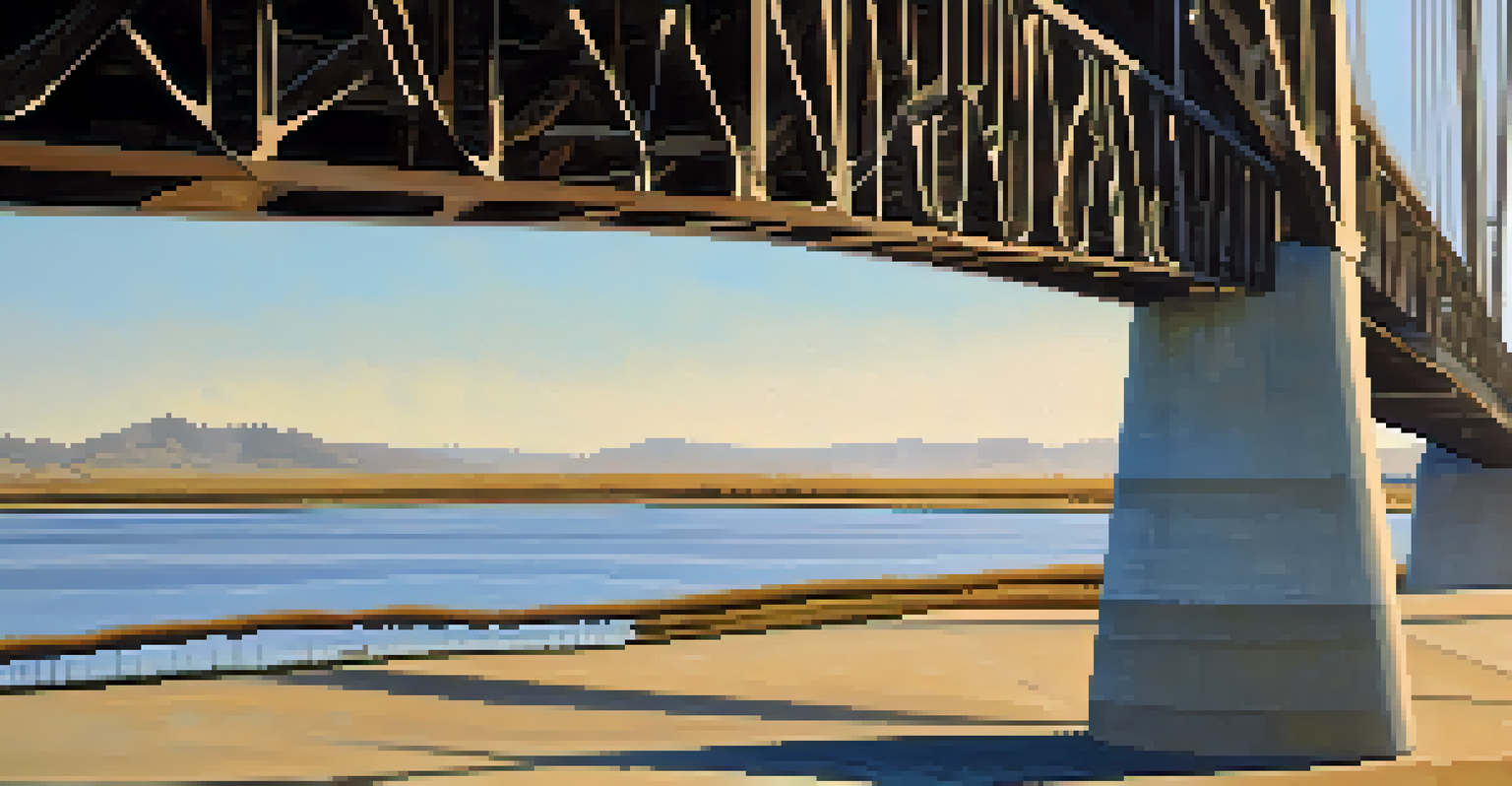The Role of Sacramento's Bridges in Urban Development History

Historical Importance of Sacramento's Bridges
Sacramento's bridges have played a pivotal role in the city's growth since its founding during the Gold Rush era. Each bridge not only served as a means of transportation but also as a symbol of progress and innovation. For example, the iconic Tower Bridge, completed in 1935, became a crucial connection for both vehicles and pedestrians, facilitating trade and movement across the Sacramento River.
Bridges are a symbol of unity and connection; they link communities and create pathways for progress.
As the city expanded, these structures evolved from simple crossings to intricate designs that showcased engineering advancements. The construction of these bridges often marked the beginning of new neighborhoods and commercial areas, reflecting the changing dynamics of urban development. They became landmarks, drawing attention to Sacramento's architectural evolution while meeting the demands of a growing population.
Moreover, the historical significance of these bridges extends beyond their physical presence; they represent the community's resilience and adaptability. Their stories are intertwined with the lives of the citizens, making them vital components of Sacramento's identity and history.
Bridges as Catalysts for Economic Growth
The construction of bridges in Sacramento has historically stimulated economic development in the region. By enhancing accessibility, these structures opened up new areas for businesses and residential developments. For example, as the city grew westward, the addition of the I Street Bridge in 1911 allowed for the rapid expansion of industries along the riverfront, creating jobs and attracting new residents.

Furthermore, the ability to transport goods efficiently across the river was a game-changer for local commerce. Businesses flourished as customers could easily access shops and services on either side of the river. In this way, bridges functioned not merely as transit routes, but as vital arteries that pumped economic vitality into the community.
Bridges Drive Sacramento's Growth
Sacramento's bridges have historically facilitated urban expansion and economic development by improving accessibility and connecting neighborhoods.
In recent years, local government initiatives have aimed to revitalize areas surrounding these bridges, demonstrating their ongoing importance to Sacramento's economy. Investments in infrastructure and public spaces near bridges have enhanced their roles as community hubs, driving further economic growth.
Cultural Significance of Sacramento's Bridges
Beyond their practical uses, Sacramento's bridges have become cultural icons, deeply woven into the fabric of the city’s identity. They host numerous community events and festivals, offering vibrant backdrops for celebrations. The annual Bridge Festival, for instance, showcases local art and music while bringing together residents to appreciate the historical significance of these structures.
The beauty of a bridge is not just in its structure but in the connections it fosters between people and places.
Additionally, the unique designs of the bridges, like the Art Deco style of the Tower Bridge, reflect the artistic heritage of Sacramento. They inspire photographers, artists, and travelers alike, serving as symbols of beauty and creativity. This cultural resonance fosters a sense of pride among residents, reinforcing the bridges' status as beloved landmarks.
Moreover, the bridges often feature public art installations and lighting displays, further enhancing their cultural relevance. These artistic touches not only beautify the structures but also engage the community in celebrating their history and significance.
Bridges and Urban Connectivity
The role of Sacramento's bridges in enhancing urban connectivity cannot be overstated. They facilitate seamless movement between different parts of the city, breaking down geographical barriers. The construction of bridges like the Yolo Causeway has enabled residents to commute easily across the river, promoting a sense of community among neighborhoods that were once isolated.
Moreover, these structures have been instrumental in developing public transportation options. With the integration of light rail systems and bike paths alongside bridges, Sacramento has embraced sustainable transportation methods. This evolution underscores the city's commitment to creating a more connected and eco-friendly urban environment.
Cultural Icons of the City
These bridges serve as cultural landmarks, hosting community events and inspiring local art, which fosters pride and a sense of identity among residents.
As urban development continues to evolve, the importance of maintaining and upgrading these bridges remains crucial. Ensuring they meet modern needs while preserving their historical integrity is key to fostering ongoing connectivity in the city.
Environmental Impact and Sustainability of Bridges
As Sacramento continues to grow, the environmental impact of its bridges has come into sharper focus. Many bridges are now designed with sustainability in mind, incorporating eco-friendly materials and technologies. For instance, some recent projects include features that improve water quality and support local wildlife habitats, showcasing a commitment to responsible urban development.
In addition, bridges play a significant role in alleviating traffic congestion, which can positively impact air quality. By improving traffic flow and promoting public transit, these structures contribute to a healthier urban environment. This shift towards sustainable practices reflects a broader trend in urban planning that prioritizes ecological preservation alongside development.
Furthermore, community engagement in discussing the environmental implications of bridge projects has become increasingly important. Residents are now more involved in decision-making processes, advocating for designs that respect both the urban landscape and the natural environment.
Future Developments and Challenges Ahead
Looking ahead, Sacramento's bridges face both exciting opportunities and significant challenges. As the city continues to expand, the demand for efficient and innovative transportation solutions will only grow. Future bridge projects may incorporate advanced technologies, such as smart sensors and renewable energy sources, to enhance safety and efficiency.
However, maintaining and upgrading existing bridges poses financial and logistical challenges. Many structures require regular inspections, repairs, and renovations to ensure they meet safety standards. Balancing the need for modernization with budget constraints will be essential in preserving these iconic landmarks.
Future Challenges in Bridge Maintenance
As Sacramento grows, maintaining and upgrading its bridges to meet modern needs while preserving their historical significance presents financial and logistical challenges.
Additionally, community input will play a critical role in shaping the future of Sacramento's bridges. Engaging residents in discussions about development plans will help ensure that the bridges continue to serve their intended purpose while reflecting the values and needs of the community.
Preserving the Legacy of Sacramento's Bridges
Preservation efforts for Sacramento's bridges are vital to maintaining the city's history and cultural heritage. Organizations and local government are working together to protect these structures from neglect and deterioration. Initiatives to restore and maintain bridges, such as the efforts surrounding the historic Tower Bridge, highlight the commitment to honoring the city's past.
Furthermore, educational programs aimed at raising awareness about the historical significance of these bridges are crucial. By involving schools and community groups in preservation efforts, residents can develop a deeper appreciation for their local history. This collective effort fosters a sense of ownership and responsibility toward these landmarks.

Ultimately, preserving Sacramento's bridges is not just about maintaining structures; it’s about safeguarding the stories and memories they represent. As the city continues to evolve, these bridges will remain essential links to its rich past, shaping its future.